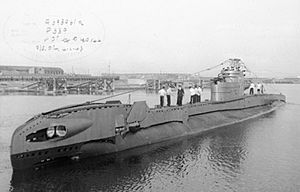Action of 13 November 1943 facts for kids
Quick facts for kids Action of 13 November 1943 |
|||||||
|---|---|---|---|---|---|---|---|
| Part of World War II, Pacific War | |||||||
 Submarine HMS Taurus underway |
|||||||
|
|||||||
| Belligerents | |||||||
| Commanders and leaders | |||||||
| Strength | |||||||
| Submarine Taurus | Submarine I-34 | ||||||
| Casualties and losses | |||||||
| None | I-34 sunk 84 killed |
||||||
The action of 13 November 1943 was a battle between submarines during World War II. It happened when the British Royal Navy submarine HMS Taurus sank the Japanese Navy's Type B1 submarine I-34 in the Strait of Malacca. The I-34 was on a secret mission, carrying important goods underwater between Japan and its German allies.
Contents
A Secret Mission in World War II
The I-34 Sets Sail
The Japanese submarine I-34, led by Commander Irie Tatsushi, left Kure to begin a special "Yanagi" mission. This mission involved secretly shipping supplies to parts of France controlled by Germany. I-34 was the third Japanese submarine to try such a long journey.
On November 11, I-34 departed Seletar for Penang. Before reaching the South Atlantic, the Germans planned for I-34 to get more fuel from a supply ship in the Indian Ocean. The I-34 was carrying valuable supplies like tin, tungsten, and raw rubber.
British Code-breakers Get a Clue
Meanwhile, secret code-breakers at Hut 7 in Bletchley Park in Britain were busy. They managed to figure out hidden messages sent in a special code between Tokyo and Berlin. These messages talked about I-34's secret mission. This important information was then sent to the British submarine Taurus, commanded by Lieutenant-Commander Mervyn Wingfield, which was operating from a base in Ceylon.
The Battle Begins
Taurus Strikes First
On the morning of November 13, 1943, about 30 miles off Penang, a lookout officer on Taurus spotted the large Japanese submarine I-34. It was traveling on top of the water at 14 knots, even though there was a sudden rain shower.
Commander Wingfield quickly fired six torpedoes. One of them hit the I-34's right side, just below its control tower. The Japanese submarine sank very quickly. Eighty-four of its crew members were killed. Only fourteen survivors managed to escape the sunken submarine and were rescued by a local Malay boat.
A Close Call for Taurus
The next morning, a Japanese submarine chaser called CH-20 from Penang attacked Taurus. The water in that area was very shallow. When Wingfield tried to escape by diving deeper, the front part of Taurus got stuck in the soft mud at the bottom of the sea.
Luckily, the explosions from several underwater bombs dropped by CH-20 shook Taurus free. Wingfield then brought Taurus just below the surface, where its periscope could see. He then surfaced the submarine and attacked CH-20 with its deck gun. The Japanese subchaser was badly damaged. Thirteen of its crew, including the captain, were killed, and seventeen others were wounded.
Aftermath of the Battle
Before Taurus could do more, a Japanese aircraft appeared. This forced Wingfield to make a quick dive, which put the submarine in danger as it leaked a lot of water. However, Taurus escaped with only minor damage and managed to return safely to its base in Ceylon.
After I-34 was lost, the Japanese Navy changed the routes for all their submarines heading to Europe, keeping them away from Penang. The sinking of I-34 was the first time a Japanese submarine was sunk by a British Royal Navy submarine.

